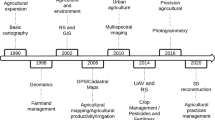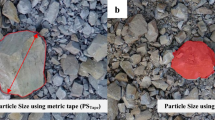Abstract
Monitoring has been considered to be the most effective means of preventing and mitigating geo-hazards. Unmanned aerial vehicle (UAV) based remote sensing has been proven to be a viable method for monitoring relatively flat areas, but has typically encountered challenges on steep mountainous slopes. The Qinglingou Slope, which is located at the head of the Three Gorges Reservoir, China, was selected as a case study, and a UAV-based remote sensing method was applied to monitor this steep mountainous slope. The UAV, which was equipped with a camera, was used to acquire images on May 10 and Sept. 13, 2015. At the same time, a plan for establishing and measuring a detailed network of ground control points (GCPs) and check points was carefully designed and implemented, according to the local conditions. Georeferenced digital surface models (DSMs) and digital orthophotos were obtained by photogrammetric processing. Based on the results, a simple and quick method that identified and quantified slope deformation by calculating and analyzing the changes in the DSMs was developed. The results showed that the UAV-based remote sensing method was rapid, safe and effective, and it could be valuable for monitoring a large number of steep mountainous slopes in the Three Gorges Reservoir.










Similar content being viewed by others
References
Booth AM, Lamb MP, Avouac JP, Delacourt C (2013) Landslide velocity, thickness, and rheology from remote sensing: la Clapière landslide, France. Geophys Res Lett 40:4299–4304
Bürkle A, Segor F, Kollmann M (2011) Towards autonomous micro UAV swarms. J Intell Robot Syst 61:339–353. doi:10.1007/s10846-010-9492-x
Colomina I, Molina P (2014) Unmanned aerial systems for photogrammetry and remote sensing: a review. ISPRS J Photogramm 92:79–97. doi:10.1016/j.isprsjprs.2014.02.013
Dewitte O, Jasselette JC, Cornet Y, Van Den Eeckhaut M, Collignon A, Poesen J, Demoulin A (2008) Tracking landslide displacements by multi-temporal DTMs: a combined aerial stereophotogrammetric and LIDAR approach in western Belgium. Eng Geol 99:11–22
Harwin S, Lucieer A (2012) Assessing the accuracy of georeferenced point clouds produced via multi-view stereopsis from unmanned aerial vehicle (UAV) imagery. Remote Sens-Basel 4:1573–1599. doi:10.3390/rs4061573
Huang H, Yi W, Lu S, Yi Q, Zhang G (2014a) Use of monitoring data to interpret active landslide movements and hydrological triggers in three gorges reservoir. J Perform Constr Facil 30:C4014005
Huang H, Yi W, Yi Q, Lu S (2014b) Real-time Monitoring And Data Analysis Of An Active Landslide In Three Gorges Reservoir. In Engineering Geology for Society and Territory - Volume 2 SE - 253, G. Lollino et al., Ed., pp. 1433–1436 m, Springer International Publishing.
Huang B, Zheng W, Yu Z, Liu G (2015) A successful case of emergency landslide response - the Sept. 2, 2014a, Shanshucao landslide, three gorges reservoir. China Geoenvironmental Disasters 2. doi:10.1186/s40677-015-0026-5
Immerzeel WW, Kraaijenbrink PDA, Shea JM, Shrestha AB, Pellicciotti F, Bierkens MFP, Jong SMD (2014) High-resolution monitoring of Himalayan glacier dynamics using unmanned aerial vehicles. Remote Sens Environ 150:93–103
Javernick L, Brasington J, Caruso B (2014) Modeling the topography of shallow braided rivers using structure-from-motion photogrammetry. Geomorphology 213:166–182. doi:10.1016/j.geomorph.2014.01.006
Jian W, Xu Q, Yang H, Wang F (2014) Mechanism and failure process of Qianjiangping landslide in the three gorges reservoir, China. Environ Earth Sci 72:2999–3013
Joyce KE, Belliss SE, Samsonov SV, McNeill SJ, Glassey PJ (2009) A review of the status of satellite remote sensing and image processing techniques for mapping natural hazards and disasters. Prog Phys Geogr 33:183–207. doi:10.1177/0309133309339563
Kasperski J, Delacourt C, Allemand P, Potherat P, Jaud M, Varrel E (2010) Application of a terrestrial laser scanner (TLS) to the study of the Séchilienne landslide (Isère, France). Remote Sens-Basel 2:2785–2802. doi:10.3390/rs122785
Lucieer A, Jong SMD, Turner D (2014) Mapping landslide displacements using structure from motion (SfM) and image correlation of multi-temporal UAV photography. Prog Phys Geogr 38:97–116. doi:10.1177/0309133313515293
Malet JP, Maquaire O, Calais E (2002) The use of global positioning system techniques for the continuous monitoring of landslides: application to the super-Sauze earthflow (Alpes-de-haute-Provence, France). Geomorphology 43:33–54
Martha TR, Kerle N, Jetten V, van Westen CJ, Kumar KV (2010) Landslide volumetric analysis using cartosat-1-derived dems. IEEE Geosci Remote Sens Lett 7:582–586
Mesas-Carrascosa F, Torres-Sánchez J, Clavero-Rumbao I, García-Ferrer A, Peña J, Borra-Serrano I, López-Granados F (2015) Assessing optimal flight parameters for generating accurate multispectral Orthomosaicks by UAV to support site-specific crop management. Remote Sens-Basel 7:12793–12814. doi:10.3390/rs71012793
Niethammer U, Rothmund S, Joswig M, Bogaard T, Malet JP (2009) UAV-based remote sensing of the slow-moving landslide Super-Sauze. Landslide Processes: 69–74
Niethammer U, Rothmund S, James MR, Travelletti J, Joswig M (2010) UAV-based remote sensing of landslides. Int Arch Photogramm Remote Sens Spat Inf Sci 38:496–501
Niethammer U, Rothmund S, Schwaderer U, Zeman J, Joswig M (2011) Open source image-processing tools for low-cost UAV-based landslide investigations. Int Arch Photogramm Remote Sens Spat Inf Sci 38:C22. doi:10.5194/isprsarchives-xxxviii-1-c22-161-2011
Niethammer U, James MR, Rothmund S, Travelletti J, Joswig M (2012) UAV-based remote sensing of the Super-Sauze landslide: Evaluation and results. Eng Geol 128:2–11. doi:10.1016/j.enggeo.2011.03.012
Niu R, Wu X, Yao D, Peng L, Ai L, Peng J (2014) Susceptibility assessment of landslides triggered by the Lushan earthquake, April 20, 2013, China. IEEE J-Stars 7:3979–3992. doi:10.1109/JSTARS.2014.2308553
Prosdocimi M, Calligaro S, Sofia G, Fontana GD, Tarolli P (2015) Bank erosion in agricultural drainage networks: new challenges from structure-from-motion photogrammetry for post-event analysis. Earth Surf Process Landf 40:1891–1906. doi:10.1002/esp.3767
Rawat MS, Joshi V, Rawat BS, Kumar K (2011) Landslide movement monitoring using GPS technology: A case study of Bakthang landslide, Gangtok, East Sikkim, India. J Dev Agric Econ 3:194–200
Santamaria E, Pastor E, Barrado C, Prats X, Royo P, Perez M (2012) Flight plan specification and management for unmanned aircraft systems. J Intell Robot Syst 67:155–181. doi:10.1007/s10846-011-9648-3
Strecha C, Küng O, Fua P (2012) Automatic mapping from ultra-light uav imagery. Paper presented at the EuroCOW 2012, Barcelona, Spain, 8-10 February 2012
Tahar KN (2012) A new approach on slope data acquisition using unmanned aerial vehicle. Intern J Res Rev Appl Sci 13:780–785
Tofani V, Segoni S, Agostini A, Catani F, Casagli N (2013) Technical note: use of remote sensing for landslide studies in Europe. Nat Hazards Earth Syst Sci 13:299–309. doi:10.5194/nhess-13-299-2013
Turner D, Lucieer A, de Jong SM (2015) Time series analysis of landslide dynamics using an unmanned aerial vehicle (UAV). Remote Sens-Basel 7:1736–1757. doi:10.3390/rs70201736
Westoby MJ, Brasington J, Glasser NF, Hambrey MJ, Reynolds JM (2012) ‘Structure-from-Motion’ photogrammetry: a low-cost, effective tool for geoscience applications. Geomorphology 179:300–314. doi:10.1016/j.geomorph.2012.08.021
Yin Y (1998) Research on geologic hazards of relocation construction at the Three Gorges Reservoir, the Yangtze River. Chinese J Geol Hazard Cont 9:59–66 (in Chinese)
Acknowledgements
This work was supported by the National Natural Science Foundation of China (41302260/D0215), the Open Research Fund of the Key Laboratory of Disaster Prevention and Mitigation of Hubei Province (2016KJZ16), the Open Research Fund of the Hubei Key Laboratory of Intelligent Vision Based Monitoring for Hydroelectric Engineering (2016KLA02), and in part by the Hubei Science and Technology Support Program (2015 BCE070, 2015 BCE038) and the Innovation Groups Project of the Natural Science Foundation of Hubei Province (2015CFA025).
Author information
Authors and Affiliations
Corresponding author
Additional information
Communicated by: H. A. Babaie
Rights and permissions
About this article
Cite this article
Huang, H., Long, J., Lin, H. et al. Unmanned aerial vehicle based remote sensing method for monitoring a steep mountainous slope in the Three Gorges Reservoir, China. Earth Sci Inform 10, 287–301 (2017). https://doi.org/10.1007/s12145-017-0291-9
Received:
Accepted:
Published:
Issue Date:
DOI: https://doi.org/10.1007/s12145-017-0291-9




